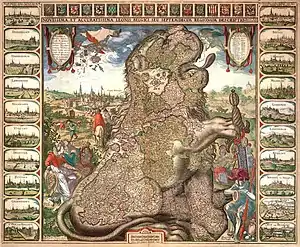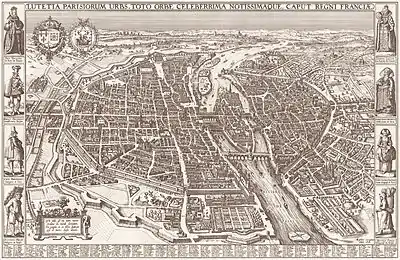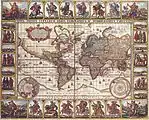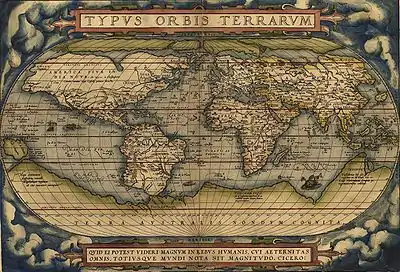Claes Jansz. Visscher
Claes Janszoon Visscher (1587 – 19 June 1652) was a Dutch Golden Age draughtsman, engraver, mapmaker, and publisher.
(1619%252C_Claes_Jansz._Visscher).jpg.webp)

Biography
Visscher, who was born and died in Amsterdam, was also known as Nicolas Joannes Piscator[1] or Nicolas Joannis Visscher II, after his father who lived ca. 1550–1612.[2] He learned the art of etching and printing from his father, and helped grow the family printing and mapmaking business to one of the largest in his time. It was a family business; his son Nicolaes Visscher I (1618–1679), and his grandson Nicolaes Visscher II (1649–1702) were also mapmakers in Amsterdam on the Kalverstraat.[3] The times were with the Visschers for other reasons; due to the Protestant reformation, the older Bibles with their "Roman Catholic" illustrations were seen as outdated and apocryphal, but to liven up the new Protestant Bibles for the less well-read clergy, the Visschers produced illustrated maps and even landscapes of the places in the Bible. This became a very successful family business, with collaboration with many respected draughtsmen of the day. A new translation of the Bible was underway in the Netherlands, and until then, the new German translation done by Johannes Piscator, published in 1602–1604, was translated into Dutch.[4] Though probably not a relative, his Bible translation was accepted by the Dutch Staten-General in 1602, which only lent more publicity and authenticity to the "Fisher" name.
The trademark of the Visschers was a fisherman, after their name (thus the Latin nickname Piscator). A small fisherman would be strategically placed somewhere near water. If the subject was a landscape without a stream or pond, then often a figure walking with a fishing rod can be seen. Their map plates were reused for a century by other printers who unknowingly copied the entire plates, including the tell-tale fishermen. Observant scholars are thus able to trace the provenance of Bibles, maps, and landscapes from these signs.
Aside from Bibles, Claes Visscher II primarily etched and published landscapes, portraits, and maps. He etched over 200 plates and his maps included elaborate original borders. Visscher died in 1652.[5] He was a publisher of prints by Esaias van de Velde, and David Vinckboons, and was a big influence on Roelant Roghman[6] and on his sister Geertruyd.[7]
Gallery
 Detail of a map from 1630 with the "Fisher logo". The signature is both the fisherman drawing and the text "by C.J.Visscher in the Kalverstraet in Amsterdam.
Detail of a map from 1630 with the "Fisher logo". The signature is both the fisherman drawing and the text "by C.J.Visscher in the Kalverstraet in Amsterdam. Fisher added to print of drawing by Geertruydt Roghman.
Fisher added to print of drawing by Geertruydt Roghman.
 1618 map of Paris by Claes Janszoon Visscher
1618 map of Paris by Claes Janszoon Visscher 1652 world map by Claes Janszoon Visscher
1652 world map by Claes Janszoon Visscher
References
- Claes Jansz. Visscher II in the RKD
- Claes Jansz. Visscher I in the RKD
- Nicolaes Visscher II in the RKD
- De Statenbijbel en zijn voorgangers., C.C. de Bruin, A.W. Sijthoff, Leiden, (1937) – text online in the DBNL
- "Claes Jansz. Visscher Biography". Retrieved 29 January 2010.
- Provincial atlas of North Holland in the North Holland Archives
- Geertruid Roghman in the Netherlands female lexicon of history
- Claes Jansz Visscher with some etchings in the Rijksmuseum
External links
| Wikimedia Commons has media related to Claes Jansz. Visscher (II). |
- Vermeer and The Delft School, a full text exhibition catalog from The Metropolitan Museum of Art, which includes material on Claes Jansz. Visscher (see index)
- Pieter Bruegel the Elder: Drawings and Prints, a full text exhibition catalog from The Metropolitan Museum of Art, which includes material on Claes Jansz. Visscher (see index)
